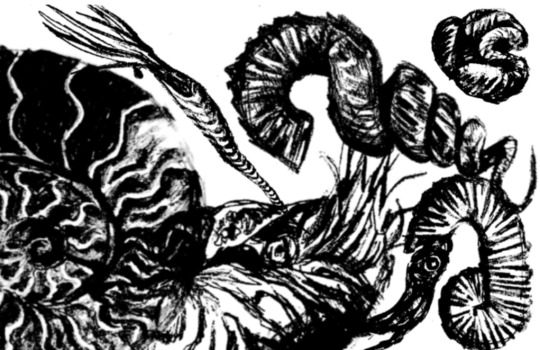#fossilized cephalopod
Explore tagged Tumblr posts
Photo
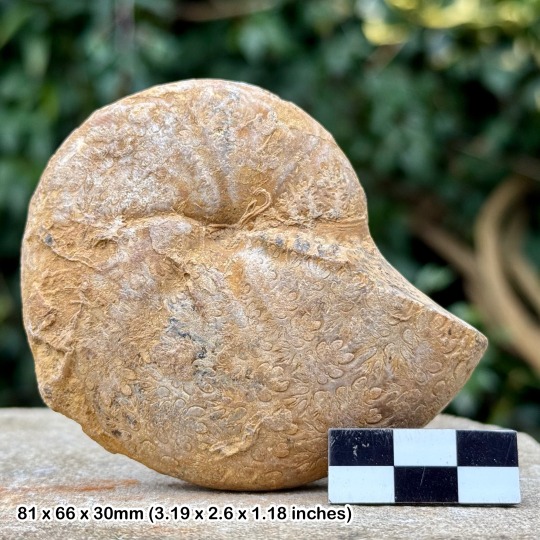
Neophylloceras (Neophylloceras) ononense Fossil Ammonite – Hauterivian, Cretaceous – Madagascar
Neophylloceras (Neophylloceras) ononense Fossil Ammonite – Hauterivian, Cretaceous – Madagascar
About the Fossil:
This exceptionally preserved Neophylloceras (Neophylloceras) ononense ammonite fossil originates from the Hauterivian stage of the Early Cretaceous (~133-129 million years ago) and was discovered in Madagascar. Neophylloceras is a genus of phylloceratid ammonites, known for their smooth, involute shells with intricate, highly lobed suture patterns. Unlike ribbed ammonites, phylloceratids have a more streamlined shell, suggesting they were active swimmers in deeper marine environments.
During the Early Cretaceous, ammonites like Neophylloceras ononense inhabited warm, tropical seas, where they played a vital role in the marine ecosystem. Their highly complex suture patterns and distinctive morphology make them particularly fascinating for both collectors and researchers. The Hauterivian-aged deposits of Madagascar are renowned for producing beautifully preserved ammonite specimens, providing crucial insights into ancient cephalopod evolution.
Geology & Formation:
Geological Age: Hauterivian, Early Cretaceous (~133-129 million years ago)
Formation: Marine sedimentary deposits
Location: Madagascar
Preservation: Excellent fossilization with well-defined suture patterns, smooth shell structure, and detailed chamber formations
Why This Fossil?
✔ 100% Genuine Specimen – Comes with a Certificate of Authenticity
✔ Rare & Highly Collectible – From the renowned Alice Purnell Collection
✔ Perfect for Display or Study – Ideal for fossil collectors, students, and paleontology enthusiasts
✔ Scale Rule/Cube = 1cm – See photos for full sizing
The fossil in the photo is the exact specimen you will receive!
📦 Secure Packaging & Fast Shipping – Your fossil will be carefully packed for a safe journey!
#Neophylloceras ononense#Hauterivian ammonite#Cretaceous ammonite#fossil ammonite#Madagascar fossil#rare ammonite#fossilized cephalopod#prehistoric marine life#marine fossil#natural history#paleontology#ammonite collection#Alice Purnell Collection#genuine fossil specimen
0 notes
Text
Ammonites were some of the most diverse organisms in the ancient ocean. The Museum holds one of the world’s largest collections of ammonites, containing nearly two million specimens that represent 300 million years of Earth’s history!
#science#amnh#museum#fossil#nature#natural history#animals#paleontology#fact of the day#ammonite#prehistoric#cephalopod#squid#fossils#museums#natural history museum#ancient animals#cool animals#ocean life#extinct animals#did you know
1K notes
·
View notes
Text

Work in progress on a goniatite painting. What other critters should I add?
#geology#geologyjohnson#palaeontology#fossils#fossilfriday#fossil#paleontology#ammonite#ammonoid#Goniatite#cephalopods#cephalopod
190 notes
·
View notes
Text

Goodnight, Orthoceras.
(AKA Getting emotional while drawing this Orthoceras fossil my friend gave me as a birthday gift.)
342 notes
·
View notes
Text
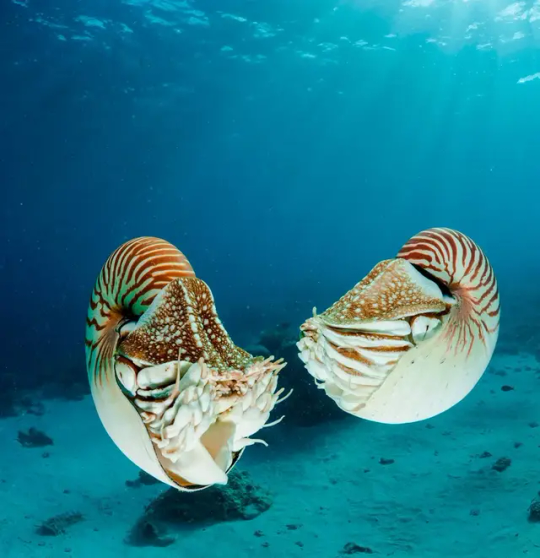

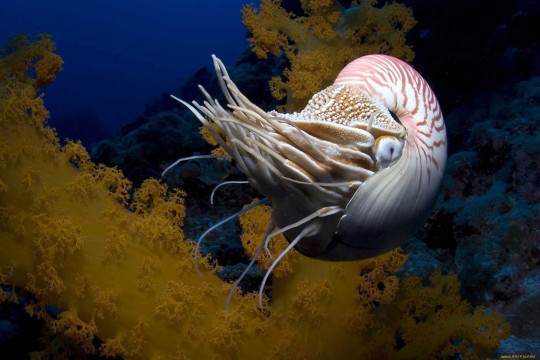
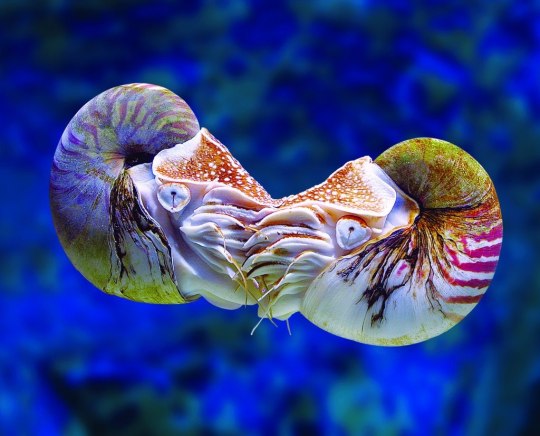
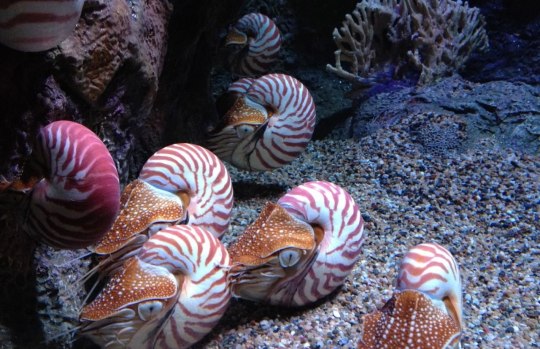
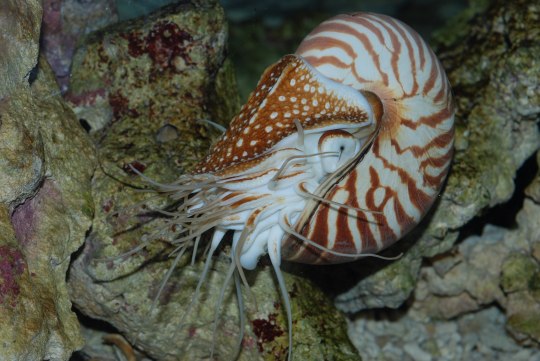
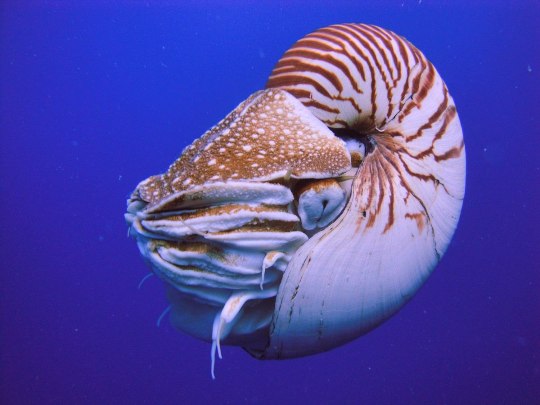
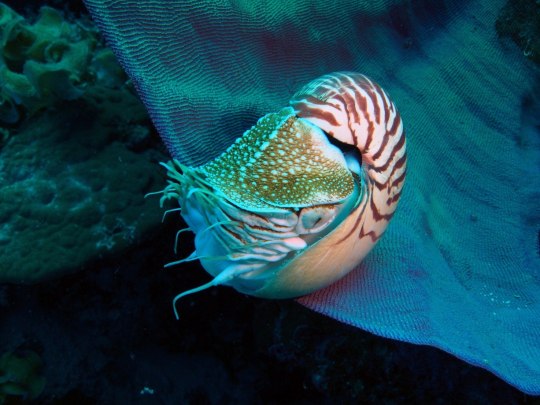




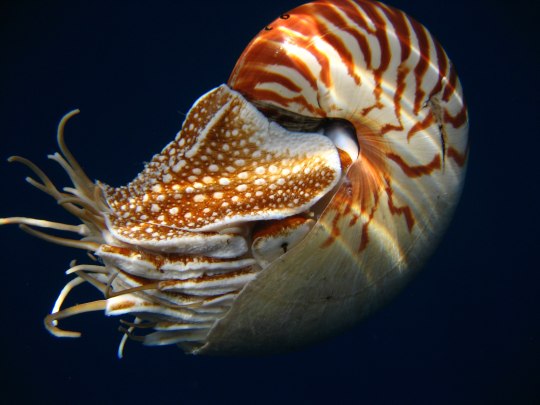
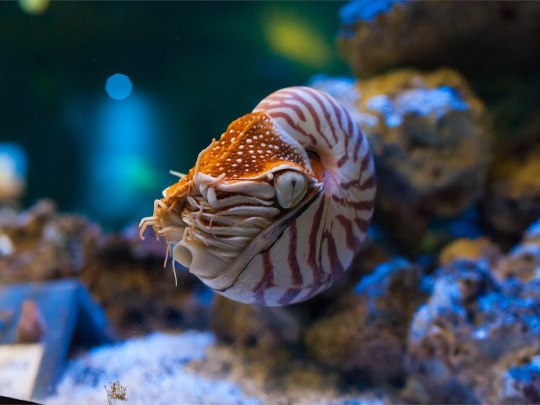
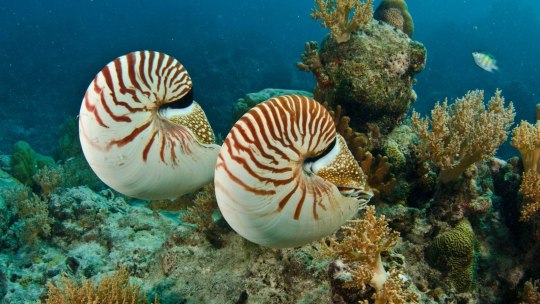
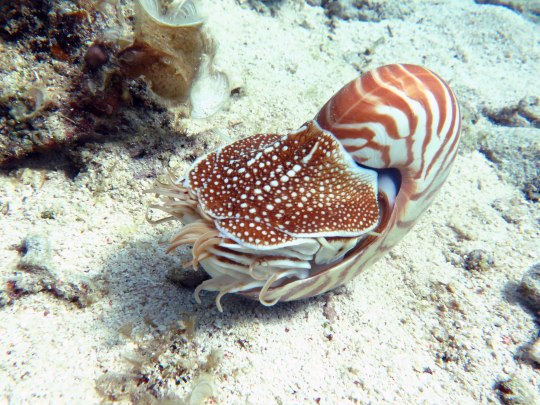
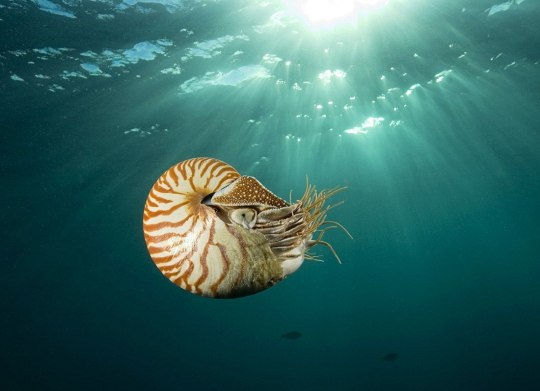

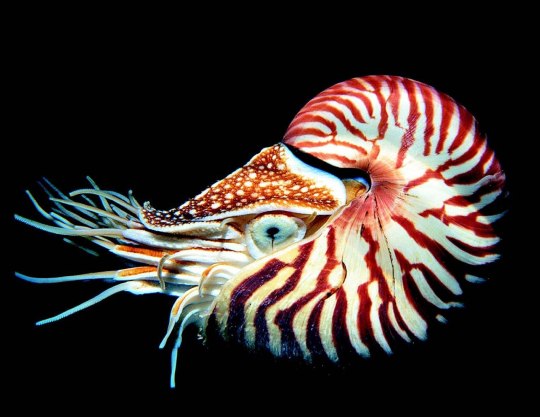

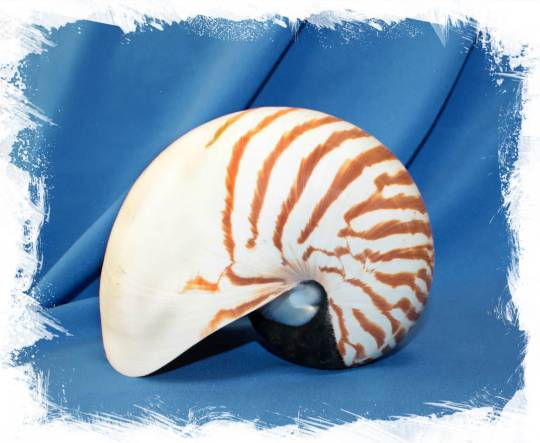
Наутилус (лат. Nautilus) — род головоногих моллюсков, которых относят к «живым ископаемым». Самый распространенный вид — Nautilus pompilius. Наутилусы относятся к единственному современному роду подкласса наутилоидей. Первые представители наутилоидей появились в кембрии, а его развитие пришлось на палеозой. Наутилиды почти вымерли на границе триаса и юры, но все же дожили до наших дней, в отличие от своих родственников аммонитов. Некоторые виды древних наутилусов достигали размера в 3,5 м. Представители самого крупного вида современных наутилусов достигают максимального размера в 25 см.
Спиральный «домик» моллюска состоит из 38 камер и «построен» по сложному математическому принципу (закон логарифмической прогрессии). Все камеры, кроме последней и самой большой, где размещается тело наутилуса с девятью десятками «ног», соединяются через отверстия между собой сифоном. Раковина наутилуса двухслойная: верхний (наружный) слой – фарфоровидный – действительно напоминает хрупкий фарфор, а внутренний, с перламутровым блеском – перламутровый. «Домик» наутилуса растет вместе с хозяином, который перемещается по мере роста раковины в камеру попросторней. Пустое жилище моллюска после его гибели можно встретить далеко от его места обитания – после гибели «хозяина» их раковины остаются на плаву и перемещаются по воле волн, ветров и течений.
Интересно, что двигается наутилус «в слепую», задом наперед, не видя и не представляя препятствий, которые могут оказаться на его пути.И еще одно удивительное качество этих древних обитателей Земли – у них потрясающая регенерация: буквально через несколько часов раны на их телах затягиваются, а в случае потери щупальца быстро отрастает новое.
Nautilus is a genus of cephalopods, which are classified as "living fossils". The most common species is Nautilus pompilius. Nautilus belong to the only modern genus of the Nautiloid subclass. The first representatives of the Nautiloids appeared in the Cambrian, and its development took place during the Paleozoic. The Nautilids almost died out on the border of the Triassic and Jurassic, but still survived to the present day, unlike their Ammonite relatives. Some species of ancient Nautilus reached a size of 3.5 m. Representatives of the largest species of modern nautilus reach a maximum size of 25 cm.
The spiral "house" of the mollusk consists of 38 chambers and is "built" according to a complex mathematical principle (the law of logarithmic progression). All chambers, except the last and largest, where the nautilus body with nine dozen "legs" is located, are connected through holes with a siphon. The nautilus shell is two–layered: the upper (outer) layer – porcelain–like - really resembles fragile porcelain, and the inner, with a mother-of-pearl luster - mother-of-pearl. The nautilus's "house" grows with its owner, who moves as the shell grows into a larger chamber. The empty dwelling of a mollusk after its death can be found far from its habitat – after the death of the "owner", their shells remain afloat and move at the will of waves, winds and currents.
Interestingly, the Nautilus moves "blindly", backwards, without seeing or imagining the obstacles that may be in its path.And another amazing quality of these ancient inhabitants of the Earth is that they have amazing regeneration: in just a few hours, the wounds on their bodies heal, and in case of loss of tentacles, a new one grows quickly.
Источник:://t.me/+t0G9OYaBjn9kNTBi, /sevaquarium.ru/nautilus/, /habr.com/ru/articles/369547/, //wallpapers.com/nautilus, poknok.art/6613-nautilus-molljusk.html, //wildfauna.ru/nautilus-pompilius, /www.artfile.ru/i.php?i=536090.
#fauna#video#animal video#marine life#marine biology#nature#aquatic animals#cephalopods#Nautilus#nautilus pompilius#living fossils#ocean#benthic#coral#plankton#beautiful#animal photography#nature aesthetic#видео#фауна#природнаякрасота#природа#океан#бентосные#головоногие моллюски#Наутилус#живое ископаемое#коралл#планктон
189 notes
·
View notes
Text
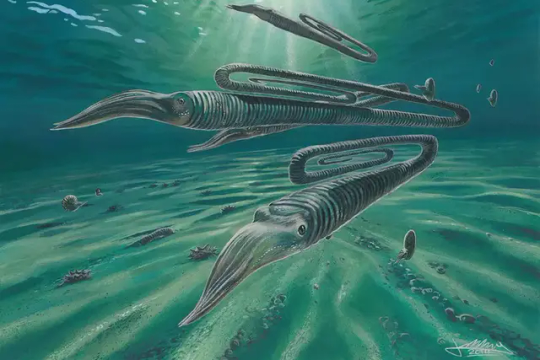
Convergent evolution is the evolution of 'analogous' or similar structures in organisms that are not closely related. Such as the wings of insects, birds and bats. One potential example of this is the Diplomoceras maximum, an extinct squid-like creature who is clearly analogous to, or a distant cousin of Clippy the paperclip. This amazing creature lived 68 million years ago, with the most notable fossil found at the cephalopod rich López de Bertodano Formation of Seymour Island, Antarctica. An area that was formerly warmer before further movement of tectonic plates. The fossil shell measured an impressive 1.5 metres and is formed from ridges, speculated to grow a section annually. These ribs are thought be similar to tree rings, being used for dating samples and gaining insight about the environment of the prehistoric sea, such as measuring the carbon and oxygen isotopes in the shell. Paleoart by James McKay
#marine biology#marine life#marine animals#ocean animals#marine zoology#cephalopods#molluscs#paleontology#fossils#ocean#wet beast wednesday#marine ecosystem#marine#zoology#animal facts#animalia#animal#sea animals#sea creature#sea creatures#sea life#ocean life
205 notes
·
View notes
Text
🐙Daily Cephalopod Fact:🐙
Chambered Nautilus: The nautilus is an octopus’ cousin. It has more than 90 tentacles — the most of any cephalopod — which it uses to feel and grope along the reefs for food. Unlike those of other cephalopods, a nautilus’s tentacles have grooves and ridges instead of suckers. The nautilus is the only cephalopod with an external shell. Much like zebras, nautiluses can be individually identified based on their striped shell patterns.

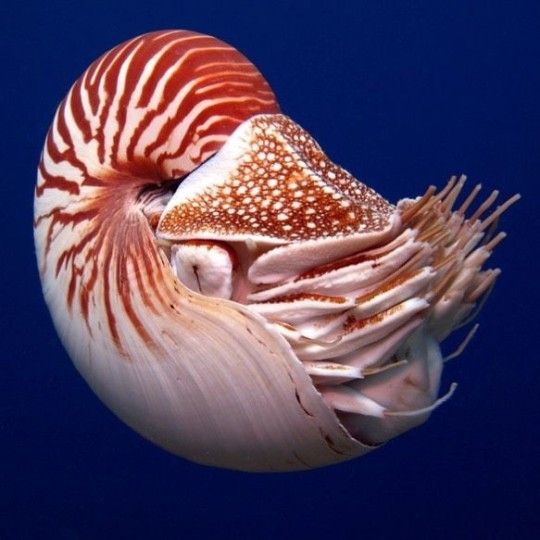
#chambered nautilus#nautilus#octopus cousin#living fossil#respect the locals#cephalopod#daily cephalopod#daily cephalopod fact#cephalopod facts#facts about cephalopods#marine#marine animals#marine biology#marine life#ocean#ocean life#shark blog
125 notes
·
View notes
Text
March Madness: Bracket 2
Welcome back for another round of March Madness! Today's competitors are Endoceras giganteum vs. Seirocrinus subangularis.
Endoceras has come up before (it was a fossil friday post during the Ordovician talks in January. It is the biggest fossil cephalopod found.

The largest specimen on record is 18 ft long (5.73m).

Seirocrinus, on the other hand is a massive crinoid from Germany. This particular one is 63 ft (18m) long (tall?) Insane, am I right?
#paleontology#fossils#fun facts#science#science education#invertebrates#science side of tumblr#march madness#cephalopod#crinoid
26 notes
·
View notes
Text

An ammonite fossil of a Sigaloceras enodatum from the Kellaways Formation in Station Quarry, South Cave, Near Hull, Yorkshire, England. This Middle Jurassic aged ammonite is preserved in calcite and is from an old English collection from a locale that is now a nature reserve.
#ammonite#cephalopod#fossils#paleontology#palaeontology#paleo#palaeo#sigaloceras#kosmoceratidae#jurassic#mesozoic#prehistoric#science#paleoblr#シガロセラス#コスモセラス科#アンモナイト#化石#古生物学
63 notes
·
View notes
Text
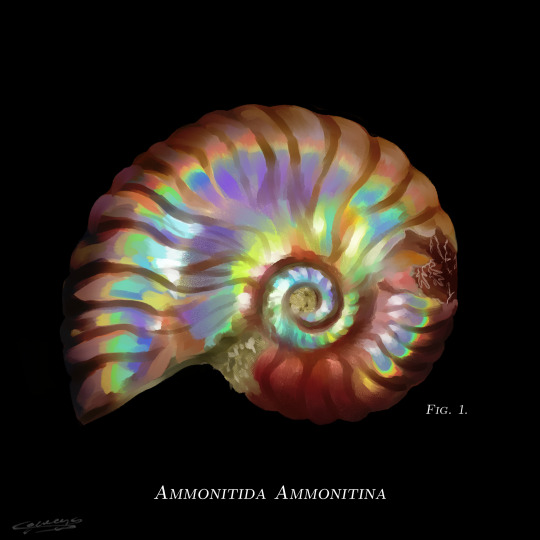
opalescent ammonite fossil
reference
#paleoart#ammonite#paleontology#art#artists on tumblr#painting#my-art#cephalopods#fossils#marine life#x
101 notes
·
View notes
Photo

Holcophylloceras sp. Fossil Ammonite – Oxfordian, Jurassic – Madagascar
Holcophylloceras sp. Fossil Ammonite – Oxfordian, Jurassic – Madagascar
About the Fossil:
This exceptionally preserved Holcophylloceras sp. ammonite fossil originates from the Oxfordian stage of the Late Jurassic (~163-157 million years ago) and was discovered in Madagascar. Holcophylloceras is a genus of phylloceratid ammonites, characterized by their highly involute, smooth shells with intricate, lobed suture patterns. Unlike heavily ribbed ammonites, phylloceratids have a more streamlined shell, suggesting they may have been strong swimmers in deeper marine environments.
During the Late Jurassic, ammonites like Holcophylloceras sp. thrived in warm, shallow to deep marine ecosystems, playing a crucial role in ancient oceanic food chains. The Oxfordian deposits of Madagascar are recognized for their rich ammonite-bearing formations, providing paleontologists and collectors with insights into the diverse cephalopod fauna of the Jurassic seas.
Geology & Formation:
Geological Age: Oxfordian, Late Jurassic (~163-157 million years ago)
Formation: Marine sedimentary deposits
Location: Madagascar
Preservation: Excellent fossilization with intricate suture patterns, smooth shell texture, and original chamber structures
Why This Fossil?
✔ 100% Genuine Specimen – Comes with a Certificate of Authenticity
✔ Highly Collectible & Rare – From the renowned Alice Purnell Collection
✔ Perfect for Display or Study – Ideal for fossil collectors, students, and paleontology enthusiasts
✔ Scale Rule/Cube = 1cm – See photos for full sizing
The fossil in the photo is the exact specimen you will receive!
📦 Secure Packaging & Fast Shipping – Your fossil will be carefully packed for a safe journey!
#Holcophylloceras sp.#Oxfordian ammonite#Jurassic ammonite#fossil ammonite#Madagascar fossil#rare ammonite#fossilized cephalopod#prehistoric marine life#marine fossil#natural history#paleontology#ammonite collection#Alice Purnell Collection#genuine fossil specimen
0 notes
Text
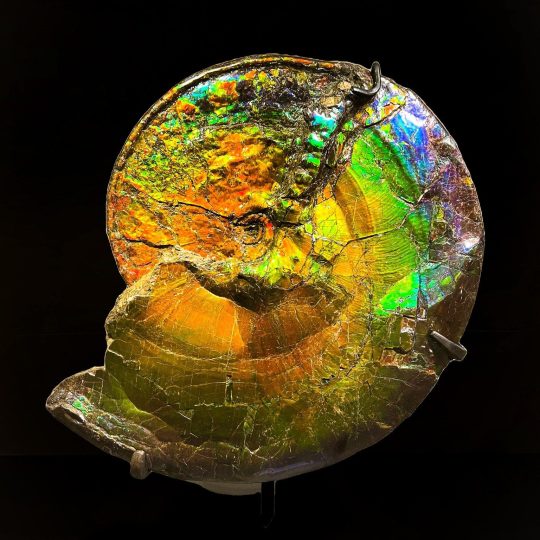
Behold the dazzling colors of an iridescent ammonite (Placenticeras intercalare)! A relative of today’s squids, this ammonite lived some 80 million years ago near what is now Alberta, Canada. This fossil’s spectacular coloration is the result of millions of years of high temperatures and pressures. As these forces acted on nacre in this ammonite’s shell, it was transformed into a gemstone known as an ammolite. Along with amber and pearl, ammolite is one of only a handful of gems made by living organisms. You can spot this rare specimen in the Louis V. Gerstner, Jr. Collections Core in the Museum’s Richard Gilder Center for Science, Education, and Innovation!
Photo: © AMNH
#amnh#museum#science#nature#fossil#natural history#animals#paleontology#ammonite#ammolite#did you know#fact of the day#rainbow#cool animals#alberta#pride#iridescent#cephalopods#squid#ancient animals
1K notes
·
View notes
Text
Early Silurian of south western Poland

#biology#palaeoart#fossils#geology#paleoart#sciart#science#palaeontology#paleozoic#paleontology#silurian period#nautilus#brachiopods#crinoid#orthoceras#endoceras#Lschnacanthiformes#Platystrophia#Baltocrinus#cephalopod
18 notes
·
View notes
Text
have you seen ticinoteuthis chuchichäschtli the tintenfischart

«Zuerst haben wir uns überlegt, die Art nach einem Kollegen zu benennen», sagte Christian Klug vom Paläontologischen Institut der UZH gegenüber der Nachrichtenagentur Keystone-SDA. «Aber das Fossil ist so unansehnlich, dass wir das niemandem antun wollten.» Stattdessen tauften sie den Tintenfisch deshalb auf den Namen «Ticinoteuthis chuchichaeschtli».
(SRF, Swiss Journal of Palaeontology)
now you have :)
#i can't get over the name. Ticinoteuthis is already wonderful we love a silly pun. and then they call him chuchichäschtli. they dug this#fossil out of a STORAGE CABINET in uzh realized it was a new kind of guy and called him chuchichäschtli. genuinely funny as hell#teeny cabinet guy. what do we call him? GOT it we'll call him tiny kitchen cabinet after The word swiss german people confuse non swiss#german people with. we're so good at this#and they ARE#id in alt#cephalopod
33 notes
·
View notes
Text
lil guys of the Ediacaran
the Ediacaran period was around ~635 million years ago, happening before the Cambrian. This time saw the rise of the first group of animals and the oldest multicellular life. The fossil record is sparse due to the fact that the creatures did not have hard shells, which are the thing most easily fossilised.
the Ediacaran biota appeared ~570 million years ago, and are very taxonomically ambiguous, they may relate to some groups, like cnidaria and protozoans, but some have suggested completely new phylums that we do not have today.
the majority of Ediacaran biota were sessile (lacking the ability to move by themselves) and were soft-bodied. many also lacked mouths and a gut.
here are some lil guys!

These frondose fossils are very controversial, considering they appear to be leafy plants, but may very well be anything from animal or protist, to stem fungi (https://www.science.org/doi/10.1126/science.1099727)
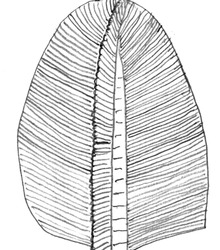
this is an Erniettamorph and we know basically nothing about these! The fossils were found in places where photosynthesis would not have been possible, and one type of these fossils has been found with the tubes completely covered and filled with sand, which makes the possibility of osmotic feeding from the surrounding water difficult as it would reduce the metabolically active volume. (https://www.pnas.org/doi/full/10.1073/pnas.0904836106)

Dickinsonia is a more studied animal. and it probably was an animal, due to cholesterol molecules found in fossils. Fossils range from millimetres to ~1.4 metres, and have near bilateral symmetry and rib-like segments. They were a mobile creature and ate microbial mats (trace fossils have been found which are most likely impressions from feeding) (https://doi.org/10.1017/S175569102300004X) A study from 2022 has suggested that they temporarily stuck themselves to substrate with mucus, which suggests a life in shallow waters (https://doi.org/10.1017/S0016756821000194)
support me on ko-fi?
#some of these articles are not freely available#so i might get the pdfs for people and drop them in a google drive if people would like#marine biology#ediacaran period#eddie in the ocean#dickinsonia#erniettamorph#frondose#fossils#paleontology#im on a paleo posting spree because this is what we r doing in lectures#i think ive had one singular lecture about modern animals (it was a cephalopods one)#oh wait no i had one on cnidaria and porifera ignore me#queue are in the ocean
49 notes
·
View notes
